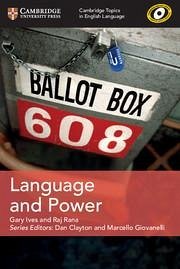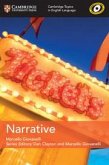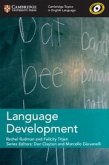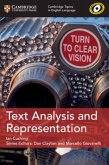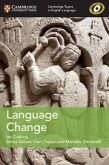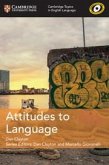- Broschiertes Buch
- Merkliste
- Auf die Merkliste
- Bewerten Bewerten
- Teilen
- Produkt teilen
- Produkterinnerung
- Produkterinnerung
Essential study guides for the future linguist.
Andere Kunden interessierten sich auch für
![Cambridge Topics in English Language Language and Gender Cambridge Topics in English Language Language and Gender]() Felicity TitjenCambridge Topics in English Language Language and Gender34,99 €
Felicity TitjenCambridge Topics in English Language Language and Gender34,99 €![Cambridge Topics in English Language Narrative Cambridge Topics in English Language Narrative]() Marcello GiovanelliCambridge Topics in English Language Narrative30,99 €
Marcello GiovanelliCambridge Topics in English Language Narrative30,99 €![Cambridge Topics in English Language Language Development Cambridge Topics in English Language Language Development]() Rachel RudmanCambridge Topics in English Language Language Development34,99 €
Rachel RudmanCambridge Topics in English Language Language Development34,99 €![Cambridge Topics in English Language Text Analysis and Representation Cambridge Topics in English Language Text Analysis and Representation]() Ian CushingCambridge Topics in English Language Text Analysis and Representation34,99 €
Ian CushingCambridge Topics in English Language Text Analysis and Representation34,99 €![Cambridge Topics in English Language Language Change Cambridge Topics in English Language Language Change]() Ian CushingCambridge Topics in English Language Language Change34,99 €
Ian CushingCambridge Topics in English Language Language Change34,99 €![Cambridge Topics in English Language Attitudes to Language Cambridge Topics in English Language Attitudes to Language]() Dan ClaytonCambridge Topics in English Language Attitudes to Language34,99 €
Dan ClaytonCambridge Topics in English Language Attitudes to Language34,99 €![Cambridge Reading Adventures a World of Deserts Gold Band Cambridge Reading Adventures a World of Deserts Gold Band]() Kathryn HarperCambridge Reading Adventures a World of Deserts Gold Band9,99 €
Kathryn HarperCambridge Reading Adventures a World of Deserts Gold Band9,99 €-
-
-
Essential study guides for the future linguist.
Hinweis: Dieser Artikel kann nur an eine deutsche Lieferadresse ausgeliefert werden.
Hinweis: Dieser Artikel kann nur an eine deutsche Lieferadresse ausgeliefert werden.
Produktdetails
- Produktdetails
- Cambridge Topics in English Language
- Verlag: Cambridge University Press
- Seitenzahl: 144
- Erscheinungstermin: 25. Januar 2018
- Englisch
- Abmessung: 227mm x 154mm x 12mm
- Gewicht: 194g
- ISBN-13: 9781108402132
- ISBN-10: 1108402135
- Artikelnr.: 48916665
- Herstellerkennzeichnung
- Libri GmbH
- Europaallee 1
- 36244 Bad Hersfeld
- gpsr@libri.de
- Cambridge Topics in English Language
- Verlag: Cambridge University Press
- Seitenzahl: 144
- Erscheinungstermin: 25. Januar 2018
- Englisch
- Abmessung: 227mm x 154mm x 12mm
- Gewicht: 194g
- ISBN-13: 9781108402132
- ISBN-10: 1108402135
- Artikelnr.: 48916665
- Herstellerkennzeichnung
- Libri GmbH
- Europaallee 1
- 36244 Bad Hersfeld
- gpsr@libri.de
1. Language and power: 1.1. Inequality and power imbalance in society
1.2. The power of language
2. Types of power: 2.1. Concepts about power
2.2. Politeness as a power tool
2.3. Power and genre
3. Language, power and the media: 3.1. Access to the media
3.2. The language and power of journalism
3.3. The language and power of advertising
3.4. The language and power of charity appeals
4. Language, power and occupation: 4.1. Exclusive features of occupational language
4.2. Workplace interactions
4.3. The negotiation of roles: the customer is always right
5. Language, power and education: 5.1. Traditional classroom discourse
5.2. A more collaborative classroom
6. Language, power and politics: 6.1. Ideology and critical discourse analysis
6.2. Political rhetoric in speeches, interviews and debates
7. Language, power and the law: 7.1. A register rooted in tradition
7.2. Functions and features of legal language in written discourse
7.3. Spoken language in the courtroom
Ideas and answers
References.
1.2. The power of language
2. Types of power: 2.1. Concepts about power
2.2. Politeness as a power tool
2.3. Power and genre
3. Language, power and the media: 3.1. Access to the media
3.2. The language and power of journalism
3.3. The language and power of advertising
3.4. The language and power of charity appeals
4. Language, power and occupation: 4.1. Exclusive features of occupational language
4.2. Workplace interactions
4.3. The negotiation of roles: the customer is always right
5. Language, power and education: 5.1. Traditional classroom discourse
5.2. A more collaborative classroom
6. Language, power and politics: 6.1. Ideology and critical discourse analysis
6.2. Political rhetoric in speeches, interviews and debates
7. Language, power and the law: 7.1. A register rooted in tradition
7.2. Functions and features of legal language in written discourse
7.3. Spoken language in the courtroom
Ideas and answers
References.
1. Language and power: 1.1. Inequality and power imbalance in society
1.2. The power of language
2. Types of power: 2.1. Concepts about power
2.2. Politeness as a power tool
2.3. Power and genre
3. Language, power and the media: 3.1. Access to the media
3.2. The language and power of journalism
3.3. The language and power of advertising
3.4. The language and power of charity appeals
4. Language, power and occupation: 4.1. Exclusive features of occupational language
4.2. Workplace interactions
4.3. The negotiation of roles: the customer is always right
5. Language, power and education: 5.1. Traditional classroom discourse
5.2. A more collaborative classroom
6. Language, power and politics: 6.1. Ideology and critical discourse analysis
6.2. Political rhetoric in speeches, interviews and debates
7. Language, power and the law: 7.1. A register rooted in tradition
7.2. Functions and features of legal language in written discourse
7.3. Spoken language in the courtroom
Ideas and answers
References.
1.2. The power of language
2. Types of power: 2.1. Concepts about power
2.2. Politeness as a power tool
2.3. Power and genre
3. Language, power and the media: 3.1. Access to the media
3.2. The language and power of journalism
3.3. The language and power of advertising
3.4. The language and power of charity appeals
4. Language, power and occupation: 4.1. Exclusive features of occupational language
4.2. Workplace interactions
4.3. The negotiation of roles: the customer is always right
5. Language, power and education: 5.1. Traditional classroom discourse
5.2. A more collaborative classroom
6. Language, power and politics: 6.1. Ideology and critical discourse analysis
6.2. Political rhetoric in speeches, interviews and debates
7. Language, power and the law: 7.1. A register rooted in tradition
7.2. Functions and features of legal language in written discourse
7.3. Spoken language in the courtroom
Ideas and answers
References.

